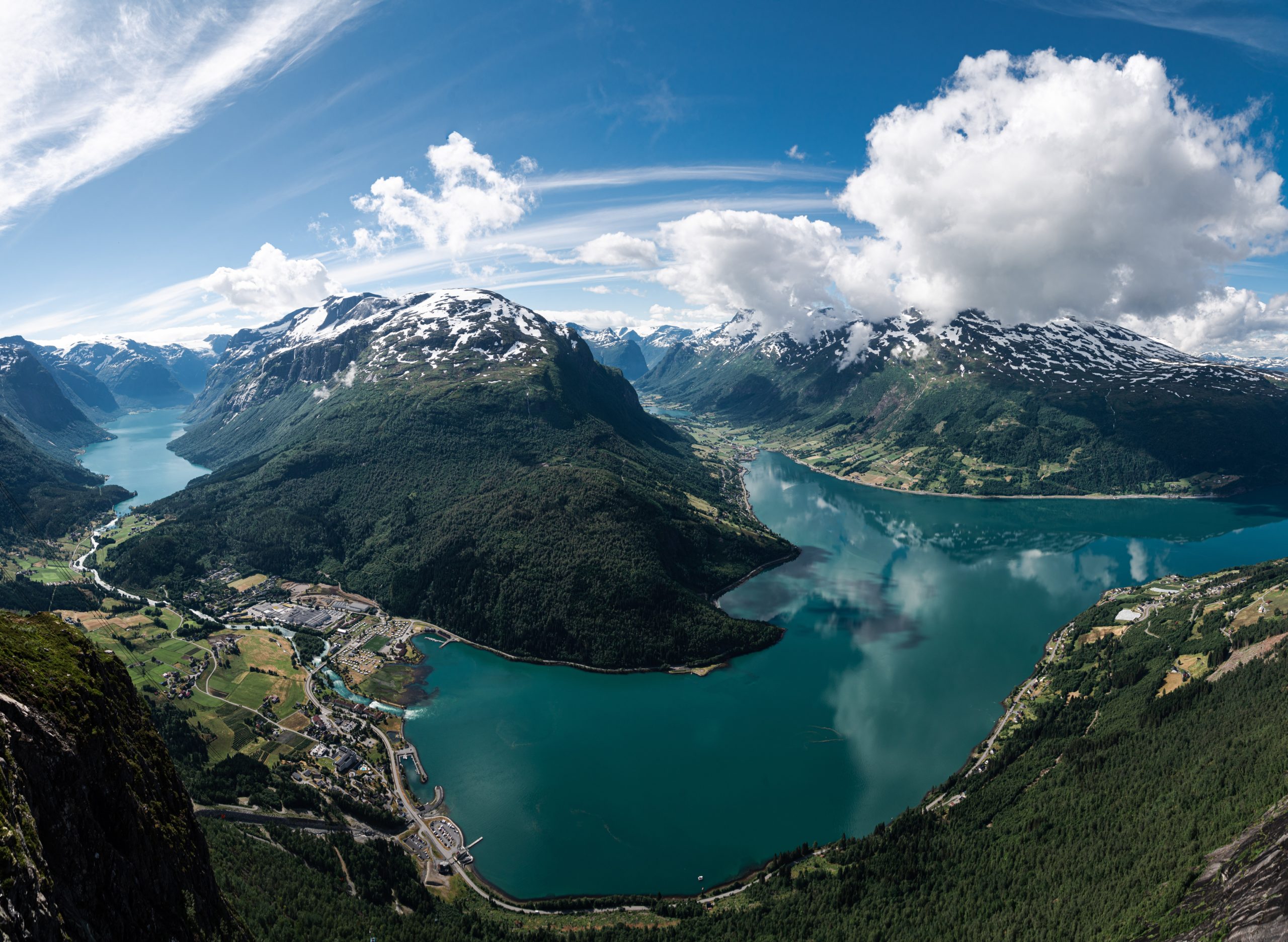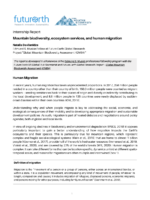Mountain Biodiversity, Ecosystem Services, and Human Migration
The blog is developed within the framework of the Edmund S. Muskie professional fellowship program, with support from the Future Earth U.S. Global Hub Secretariat and Future Earth’s Global Mountain Biodiversity Assessment (GMBA), one of its 19 Global Research Projects.
I first heard about Earth system science and planetary boundaries as a teaching assistant in my first year of graduate school. It was shortly after that I realized that these fascinating concepts were the cornerstone of the work of Future Earth and of Future Earth’s Anthropocene Magazine, which I have been actively following and reading for over three years now. After I became an Edmund S. Muskie professional development program scholar in February, I (virtually) joined the Future Earth U.S. Global Hub in May to undertake a three-month fellowship, affording me unique insights into how global sustainability science is performed, catalyzed, and disseminated.
To focus my research interests, I teamed up with the Global Mountain Biodiversity Assessment (GMBA), one of the 19 Global Research Programs of Future Earth, to explore this important aspect of sustainability. As per its name, GMBA’s core business is biodiversity in mountains, with a mission to support and facilitate international and cross-disciplinary collaboration on the assessment, conservation, and sustainable use of mountain biodiversity. With my love for mountains alongside my training in human geography and broad interest in population migration, we decided to explore the implications of various types of migration on mountain biodiversity and ecosystems, as well as the contribution of these ecosystems to the overall well-being of mountain communities. A focus on mountains is particularly relevant as their ecosystems are exposed to immense pressures – not the least because of climate change and land-use change – with far-reaching consequences for humans and nature, both locally and beyond.
Literature on human migration and the environment is plentiful and its analysis beyond the scope of a summer internship. Therefore, we decided to focus on the recent reports of the Intergovernmental Science-Policy Platform on Biodiversity and Ecosystem Services (IPBES), which we scrutinized with a migration lense on. These reports are the outcome of thematic, regional, and global assessments of current knowledge on biodiversity, ecosystem services, and their interlinkages and don’t address human migration nor mountains specifically. Yet, with no prior exposure to these assessments and to the conceptual framework adopted by IPBES to unpack the relationship between Nature and People, their evaluation was immensely useful for my understanding of the place and role of human migration in the complex interactions between the natural world and human societies and highlighted the value of looking into the intersection of social and environmental (natural) processes. Based on my reading of the reports, I organized the information I extracted using three categories: human migration as a driver of environmental change, as a human strategy to respond to environmental change, and as a practical tool to address or mitigate impacts of change. A synthesis of this information is available in my internship report.

Human migration is a complex process. Reasons for migration are individual, often informed by various intertwined factors, and consequences are multiple. I found it particularly interesting to think of these interrelations, and synthesize the incentives shaping human decision-making on migration, in the context of the human wealth to poverty spectrum. While poverty perpetuates socio-economic and environmental change in certain mountainous rural areas, it also pushes people to search for alternatives to their livelihoods in different places. Often this search manifests itself in rural-urban migration. The impacts of such a migration are observable both at the places that people left and where they move to.
Land abandonment with its consequences on biodiversity is frequently associated with out-migration from rural mountains. Rapid urbanization and overexploitation (both around urban settlements and in surrounding rural areas), in turn, are some of the consequences of in-migration to urban areas that are causing rapid land degradation. Yet, whereas out-migration typically has negative impacts on nature and is often associated with a loss of indigeneous and local knowledge in rural mountain areas, it also contributes to human wellbeing as the material and social remittances that migrants can send back to their homes facilitate social and environmental development there.
On the opposite side of the development spectrum, affluence creates different sets of incentives for people to migrate. They don’t move out of the necessity to survive environmental change but in order to diversify their experiences, income sources, and receive pleasures from the natural amenities available away from large urban centers. Effects of the affluence-led counterurbanization process on mountain ecosystems and biodiversity are multiple and are driving profound social and cultural changes, including rural gentrification, land-use change, and even conflicts between new and old settlers.
However, regardless of motivations, we should not forget about the people for whom migration is not an option. Multiple factors can cause immobility. Even amid global environmental change, conflicts, or other socio-economic change, people might be trapped in hazardous places, unable to respond by moving to different areas.
Understanding why and when people migrate is key to addressing the social, economic, and ecological consequences of their mobility and to developing appropriate migration and sustainable development policies. In view of ongoing declines in biodiversity and environmental degradation, I now recognize the importance to gain a better understanding of how migration impacts the Earth’s ecosystems and their species in the Anthropocene. This is particularly true for mountain regions: together, the challenges brought about by human migration out of and into mountain areas could weaken the fabric of fragile mountain settlements and ecosystems, bring or exacerbate uneven social dynamics, and result in cascading and long-lasting social and environmental impacts.
We are losing biodiversity and deteriorating ecosystem services globally. However, when hearing about this detrimental loss, many still separate people from nature. We must accept the human impact on our environment as part of the socio-ecological system we live in the Anthropocene era. As eloquently outlined by Johan Rockström, we indeed are a big world on a small planet – not only because we are more in numbers than at any point in human history, but also because we have spread across the globe, impacting the planet from multiple dimensions and continuously on the move. Human migration has taken on unprecedented proportions: 258 million people lived in countries different from their country of origin in 2017, and sudden-onset disasters within their own countries displaced 8.8 million people in 135 countries. In 2020, while the COVID-19 pandemic challenges the world, we are trying to adapt to this new reality of restrained mobility. But, while we concentrate on tackling this immediate crisis, we also need to remember the reality in which we entered 2020, and will have to face after we come out of this crisis. The environment is changing in the places we live, and for some, migration is one way to adapt to this changing environment. The intersection of human migration and environmental change is a connection between social and natural systems that needs to be discussed holistically.
If you want to learn more about the Global Mountain Biodiversity Assessment or get involved in ongoing efforts , don’t hesitate to contact us.
You can read the full internship report by Natalia Davlianidze entitled: Mountain Biodiversity, Ecosystem Services, and Human Migration here.
DATE
September 2, 2020AUTHOR
Natalia DavlianidzeSHARE WITH YOUR NETWORK
RELATED POSTS
Future Earth Experts Contribute to “10 Must Knows” as a Guide to Preserving Biodiversity
Research Led By Future Earth Network Finds Sub-National Data is Crucial for Global Mountain Biodiversity Conservation
IPBES Report Provides Evidence, Tools & Options to Help Governments Achieve New Global Goal on Invasive Alien Species
